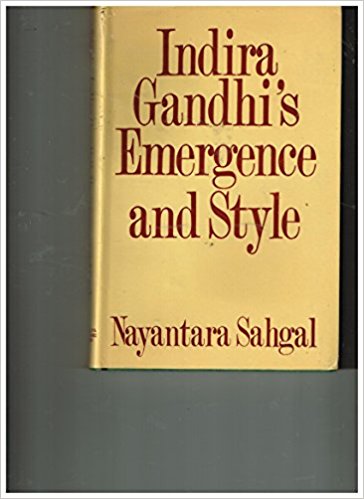As another addition to the spate of publications on Indira Gandhi and Emergency, this book does not provide any fresh insights into either the personality of the former Prime Minister or on the economic/political developments which led to centralization of the state in the form of Emergency. Unfortunately, but not surprisingly the personality of Indira Gandhi overrides all other considerations. As the author puts it, ‘we were moving inexorably towards an authoritarian order …. because of the …. needs of her own nature which had little to do with the reason and rhyme of the Indian situation.’
In the first two chapters, Mrs. Sahgal describes the childhood, education and the family traditions of Indira Gandhi, which according to her, provided every opportunity for training in democratic ideals. However, unfortunately for India and for the Nehru family ties, the temperament of Nehru’s daughter clashed with this inheritance. As a member of decision-making bodies of the National Congress, such as the Congress Working Committee and the Central Parliamentary Board, Indira Gandhi had during her father’s time gained political experience. But she was never exposed to the process leading up to these decision-making posts—she had not faced an electorate until 1967—long after becoming Prime Minister. The division of Bombay State and the imposition of President’s rule in Kerala in 1960 revealed that she was ‘action-oriented’.[ih`c-hide-content ihc_mb_type=”block” ihc_mb_who=”unreg” ihc_mb_template=”1″ ]
The emergence of Indira Gandhi in 1967-69 shows up her political style and behaviour which the author repeatedly contrasts with those of Nehru. But vital points are missed. The emergence (after 1967) of opposition rule based on electoral alliances in several states and the erosion of the domination of the Congress took place within the context of a severe recession and growing political instability. The large-scale middle class discontent took the form of communal riots in Bihar, UP, Andhra and Maharashtra.
The ideological foundations of the Congress steadily declined in this period. The Party needed a popular mandate and consent to regain its former dominance. President’s rule was merely a constitutional device, a form of domination without consent during fluctuations in parliamentary alliances. For the Congress, including the old guard, the question of revival of the Party was supreme. But there was a crisis of leadership. Politically it took the form of the struggle between Indira Gandhi (the ‘Left’) and the old guard (the ‘Syndicate’). As Mrs. Sahgal admits, ‘ideas and issues were fogged by political theatre.’ There were very few differences in the economic policies of the two sides. For the old guard who dominated the Congress Working Committee the question was control of the Government. For Indira Gandhi it was the question of her individual leadership. This was reflected in the Presidential election.
The Congress defeats in the 1967 elections revealed the loss of its social base among the rural and urban petit-bourgeoisie. For Indira Gandhi and the Congress the organization problem had to be solved before the 1971 general elections. Having failed to get her candidate selected for the Presidential post, Indira Gandhi introduced her programme ‘jotted down in a hurry, in about one and a half hours’—proposing a ban on the entry of big capital into consumer industries, a licensing policy to curb the growth of big capital, nationalization of banks etc. Most members of the Old Guard welcomed it except Morarji Desai and S.K. Patil so the rift was not on economic issues as such. But the timing of introduction of these issues took the Party by surprise. Indira Gandhi was seeking the support of the urban and rural petit-bourgeoisie. Nationalization of banks widened the credit base of this strata which included rich and middle peasants, small industry, traders, artisans, etc.
According to the author, the new era of populist politics, arranged rallies, leadership cult, intrigue and manipulation became the order of the day under Indira Gandhi. During the national movement Mahatma Gandhi was the political investment of G.D. Birla. For K.K. Birla the Maruti car was a major investment.
The next few chapters touch upon the growth of a ‘committed’ civil service, judiciary, press and the frequent use of the Presidential Ordinance. The PM takes over Home, Intelligence, Police, Election Commission, RAW and Revenue Intelligence under her immediate control. All criticism is regarded as a personal attack on her. On a bogus platform of ‘Garibi Hatao’—the mid-term elections returned a number of Party candidates who did not wince when the MISA was passed in 1971 or severe repression was carried out in Bengal through the Preventive Detention Act.
After relating the events leading to Emergency—the growth of the JP movement in Bihar, suppression of the railway strike, the Allahabad verdict and finally the resistance and the emergence of a national alternative to the Congress,. Mrs. Sahgal concludes that Indira Gandhi’s personal style broke the whole content of the Congress past and altered fundamentally the Indian political process and institutions. This change in political values and ethics marked the distance between the India of Jawaharlal Nehru and that of his daughter.
Vanaik is a freelance journalist.
[/ihc-hide-content]

